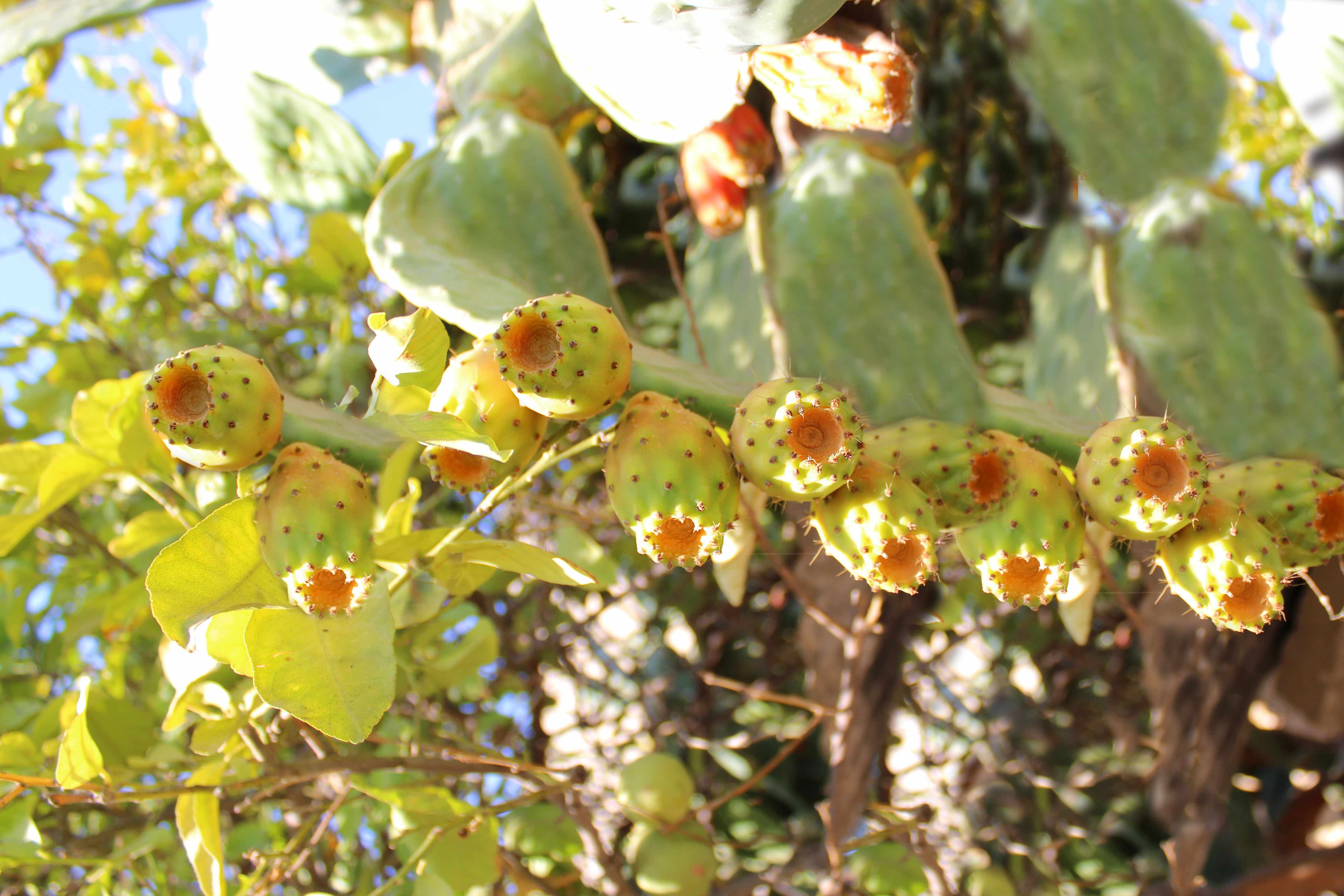Prickly Pear
...a delicious summer fruit!
The prickly pear is one of many favoured summer fruit of Cypriots. It may look like an exotic fruit but it should not be envious for not being one, due to it's exquisitely delicious taste. I would class it as a wild fruit due to the fact this prickly cactus grows in areas where of drought and during very hot weather. In Cyprus it is easy to find, you will see the plant in almost all parts of the island.
Theoretically it seems that the origin is from Mexico. If you see the flag of Mexico the prickly adorn their flag. In Europe it seems to brought by the explorer Fernando Cortez in the 15th century. Mexicans consider prickly as a weapon against disease and there is no doubt!
Those who haven't tried do not hesitate to cut them because it has thorns. With the necessary clothing and with a little preparation you will rewarded without regret, not only for the piquancy but it does very good for our health and can quench us since it contains 85% water.
The flowers first appear approximately in April. The prickly pear are ready for cutting early on July to early September, if you cut them later you will see that are melt easily and aren't have good taste. The fruit evenly grow on the edges of the prickly pear leaves and are yellowish-green and then when they are more mature are yellow-orange.
The fruit contains numerous small seeds and it is better not to eat a lot because it creates constipation and those who are constipated is better to eat few but is laxative if consumed without seeds. It's eaten raw, baked and made juice or marmalade. It is suitable for dieters since it has almost no calories! HERE you can see my video how to make the prickly pear juice without the seeds.
Planted too easily as almost all cactus and can reach heights up to 5 meters. It consists of fleshy flat sheets and on their edge stem shoots beautiful flowers then after becoming fruit. Even if one of the leaves touch the ground will take roots, so prickly will spread making it very easy to reproduction. Be careful not to let it grow a lot because then you want to cut it and it's difficult. So it is often used as plant-hedges. Hedges of prickly can act as a deterrent to the spread of forest fires because the fleshy body contains water and burned difficult. It will be good if we use this method to fight the fires that plague our island every year or to be output as they may significantly bring economic benefits from cultivating.
How can you cut prickly pears?
The summer of Cyprus sometimes becomes intolerable and will be very excruciating to wear long pants and long clothes and gloves. Personally, I'm with my shorts casual clothes, having with me thick plastic gloves and I'm very careful. I'm taking with me a bucket and what I use to cut the barbed fluffy fruit is a can of soft drink which I cut in half. If it's windy it is better to stand from the way the air goes (having air at your back) and the leaves in front of you, so when you cutting the fruits, thorns will not come upon you. When you hear some say that the thorns of prickly pear fly it's true. Not because it puts wings ... but because small plush thorns are easily removed from the fruit and hovered in the air and many of them come into contact with skin. The thorns are not visible to the eye and you will not feel them the same time on your skin, but after some time when there is friction on the skin from anything, their sharp edge will pierce you and will create itch and pain but is tolerated.
The cleaning of the thorns of prickly pear, is as follows:
If you don't have the prickly pears into a bucket you should put them. Pour water through rubber water with pressure and you will see coming out big and small spines from the fruits. Because prickly pears that are being underneath the bucket will still have thorns, stir them in the bucket with the water and prickly pears will be rubbed together with thorns entrained water. But I would not recommend to catch with bare hands. See how to clean prickly pears video HERE.
I also wanted to share with you a story that my father has tell me. A group of tourists lost in a Mexican desert when some of them were removed to explore the area and escaped from the attention of the guide. Wanting to return back to their team they got disoriented and got lost. They walked through the desert for hours but nothing. Bore 3-4 days without water but they were already dehydrated. On the 7th day they had the chance to see many prickly plants that first time in their life saw them. They impressed by the fruits because of the color, with bare hands took them and pushed the fruits. The juice run into their hands. When they realized that it is eatable, from their hunger they eat them with thorns. After days they found them all alive. Unfortunately from the thorns got bowel disturbances and infections in the mouth. Doctors however told that without this fruit would not have survive!
What do prickly pears do in our body and in our organism;
- Our skin brighter.
- Stop the aging process.
- It makes our nails stronger and our hair shiny.
- Build more powerful teeth and bones.
- Strengthens the immune system.
Diseases which prickly pear combat are:
- Lower cholesterol, lower blood pressure and strengthen blood vessels. It can prevent atherosclerosis, coronary heart disease and stroke.
- Powerful anti-inflammatory. Used as a poultice for the treatment of inflammatory abscesses, swelling of the spleen, malaria, bruises and treatment of wounds.
- Cure hyperlipidemia and obesity.
- In diabetes mellitus.
- It gives relief from arthritis, gout and muscle strain
- In prostate hypertrophy
- Cholesterol
- Beneficial for improving eyesight
- Treats osteoporosis.
- It increases the power and functionality of your brain that prevents dementia and Alzheimer's disease
- Phlebitis
- Lung diseases
- Possible factor for combating certain forms of breast cancer, prostate, stomach, lung, pancreas, because it has high levels of flavonoids and polyphenols that prevent cancer.
The leaves are used as:
- Diuretics, anti-diarrheal, and for control of sand in the kidneys, and nephritis.
- Tonics in the heart because of cacti substance containing.
- Antidote against drunkenness. Remove headaches, nausea, dry mouth and others.
- In baking sheets produce tens meat dishes and vegetables for human.
- Extracts of prickly pears download blood sugar levels of diabetic patients and in healthy people with elevated blood glucose levels. Patients with non-insulin dependent diabetes who ate cooked prickly pear leaves, showed a reduction of glucose levels in the blood, while their insulin became more effective.
- This plant contains significant levels of soluble fiber, such as pectin.
- Fibers containing believed to be responsible for the ability of cactus reduces blood sugar and lipid levels.
Nutrients: Fiber 14% carbohydrates 3%, 2% calories, protein 1%
Vitamins: Vitamin C 23%, 4% riboflavin, vitamin B6 3%, nicotinic acid 2%
Metals: Magnesium 21%, 6% calcium, potassium 6%, 4% copper

Learn what scientists say about aloe vera.

 English
English
 Ελληνικά
Ελληνικά Русский
Русский


















 Posted by
Christina Nicolaou
Posted by
Christina Nicolaou






